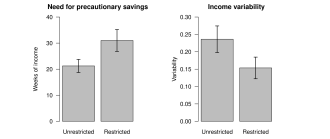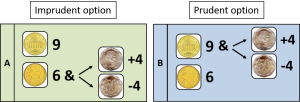Theme B: Risk and Risk preferences
![]()
In this part of the project, we study how the volatility of resource abundance influences risk preferences and how this in turn affects community-based management
Project 1: Does nature shape risk- and social preferences? Evidence from Chile, Norway and Tanzania
Authors: Florian Diekert, Robbert-Jan Schaap
Abstract: We combine survey data and administrative data from selected fisheries in Chile, Norway, and Tanzania to study whether exposure to a more risky and a more social work environment has an effect on risk- and social preferences. Our approach bridges a gap between existing case-study evidence and global estimates from historical data. While we do not find strong evidence for endogenous social preferences, we do find evidence for endogenous risk preferences, especially in Chile, where the differences in risk exposure are most pronounced. A one standard deviation increase in risk exposure is associated with a 0.08 standard deviations increase in risk tolerance globally and 0.16 standard deviations for Chile specifically. Making use of the fact that we have repeated observations from some fishers, we make a first pass at disentangling selection from adaptation as potential mechanisms that make preferences endogenous. For Chile, we find suggestive evidence for an adaptation process within fishers, while for Tanzania, the data speaks more towards a selection process that changes the composition of the population in line with risk exposure.
Status: In progress; manuscript available on request: Write to florian.diekert@awi.uni-heidelberg.de
Project 2: Risk, restrictive quotas, and income smoothing
Authors: Robbert-Jan Schaap, Exequiel Gonzalez-Poblete, Karin Loreto Silva Aedo, Florian Diekert

Abstract: Income shocks due to climate change or overexploitation can result in severe hardships for natural resource users which are unable to smooth consumption. Artisanal fishers in Chile vary in their ability to smooth consumption due to regulatory differences. Utilizing these regulatory differences, we find that survey participants that harvest species which are governed by restrictive quotas have preferences for more precautionary savings compared to survey participants whose harvest is not restricted. The inability to adjust harvest increases the importance of self-insurance through saving. Especially in developing countries, where formal saving opportunities are limited, policies that aim at stabilizing resource productivity through restrictive quotas need to account for available consumption smoothing strategies to avoid unintended welfare losses.
Status: Submitted; manuscript
Project 3: The prevalence of prudence in a risky occupation
Authors: Robbert-Jan Schaap

Abstract: In this paper I present the first experimental measurement of prudence with a subject pool that is active in a high-risk occupation. Using a lab-in-the-field experiment I measure the prudence and risk-aversion of 423 Chilean small-scale fishers. The prevalence of prudence in this sample is significantly lower than that found in other populations. The key findings are that both risk-aversion and prudence (1) correlate with preferences for more secure occupations and (2) decrease strongly with tenure and age. The second finding can in part be attributed to a gradual process of out-selection of more prudent and risk-averse fishers.
Status: Submitted; manuscript available on request: Write to robbert.schaap@awi.uni-heidelberg.de


